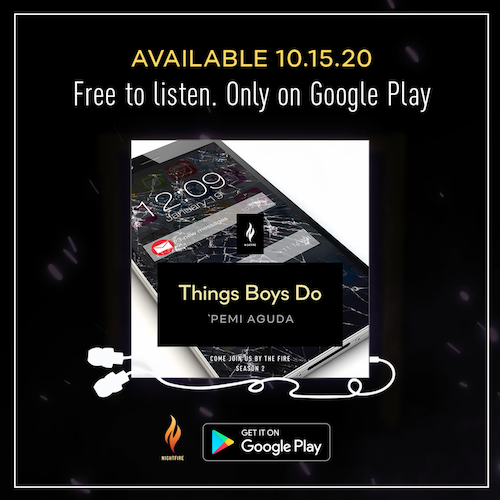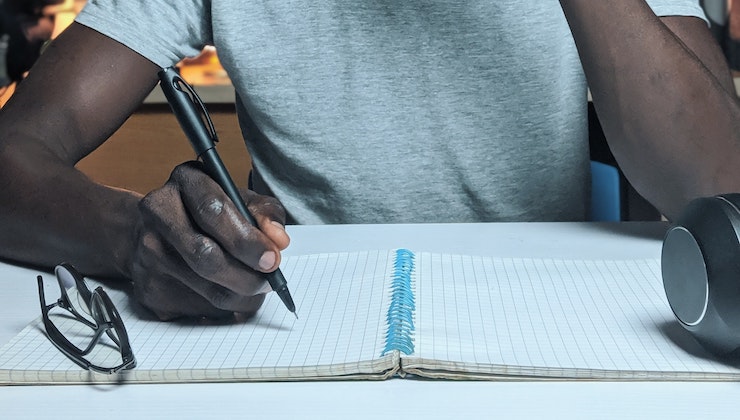To celebrate the release of the second season of Come Join Us By The Fire, our audio horror anthology, we’ve asked authors with stories included in this year’s anthology to join us and write about horror. Below, ‘Pemi Aguda, whose story “Things Boys Do” you can listen to here, writes about how horror works on a granular level, and cites some of her favorite scary writers.
blank text
Displacement in Focus: Reading Horror
Once, I was asked to be on a horror panel. Startled at being identified as a writer of horror, I spent many sweaty nights trying to figure the genre out. What is horror, and how can I trace it in my stories? Is it still horror if that was not my intent in the first place? When workshop mates threw words like ‘spooky’ and ‘eerie’ and downright ‘scary’ at me, I sat back in my chair—under that cone of silence—perplexed. Yes, horrific things sometimes happened in my stories: deaths, cannibalism, mutations, possessions, but where did horror start and end? Were those events in themselves enough to make a story a horror story? What were the readers reacting to?
I mostly consider myself to be an intuitive writer. That is, I’m not sure why anything works; it just does, trust me, okay? But by teaching creative writing, I learned how to articulate how literary choices affect how stories are read. Everything I know and do in my stories, I have absorbed from other writers I read. My stories can be unsettling and bizarre and uncanny, and it is because I am reading stories like with similar features. It is because reading is still the best teacher. For the following ‘tips’ on writing that is unsettling and eerie, I am looking to some of the writers I read over and over, to attempt to express what those readers might be reacting to in my stories.
The longer I look at the word ‘benign’, the less believable that it is a real word.
When I think of the hyper-focus that morphs a familiar thing into a strange thing, I think of the narrator in Carmen Maria Machado’s “The Resident” speaking about “Viktor Shklovsky’s idea of defamiliarization; of zooming in so close to something, and observing it so slowly, that it begins to warp, and change, and acquire new meaning.” It’s the same way we turn words over in our heads, thinking: is that how that’s really spelled? Has it always been that way? But the longer we linger, the stronger the focus, the more displaced we become. To be reunited with “the sensuous and evocative properties stripped away by recognition…” is the effect of defamiliarization.
When the narrator in Colin Winnette’s The Job of the Wasp says, “I looked to my hands, which sat like strangers on the armrests of the Headmaster’s chair,” those hands that have been used in intimate ways—digging, burying, fighting—in that book suddenly attain an unknown, even distrustful, quality. The fingernail the narrator of Laura van den Berg’s The Third Hotel finds in a hotel drawer is just a fingernail, but it has been divorced from its typical context, and that displacement is what imbues that scene with so much delicious spookiness. The world is off-kilter, off, off.
In an Angela Carter story, the narrator twists a lily sinister: “…sometimes he seemed to me like a lily. Yes. A lily. Possessed of that strange, ominous calm of a sentient vegetable, like one of those cobra-headed, funereal lilies whose white sheaths are curled out of a flesh as thick and tensely yielding to the touch as vellum.”
Staring down an ordinary thing makes it glimmer differently—reveals what can be inherently uncomfortable. By decontextualizing an object or image in new jarring ways, perhaps one can elicit a held breath, a hand to the throat.
If you stand next to me, maybe I’ll look scary too.

“Julep was the thinnest human being in town, all angles and bruises and fierce joinings. Even her lips were hard and spare and bloodless as bone. Her hair was such a pale, parched blond that it looked white and her brows and lashes were the same color, although her eyes, under heavy round lids that worked slowly as a doll’s, were brown.” This is from “Winter Chemistry” by Joy Williams, who has elevated a description of a girl to chilling levels. Bruises and fierce joinings. Bloodless as bone. The ominous doll reference.
It’s as simple as metaphors and similes sometimes. Allowing myself to see new connections where there should be none, squinting until I notice a comparison that can carry the weight. The work of borrowed meaning, transference of energy just by putting them in the same sentence, paragraph. In Yoko Ogawa’s “Afternoon at the Bakery,” a seemingly-benign story about a woman who goes into a bakery, there is this line: “Then the strawberries dried out, wrinkling up like the heads of deformed babies.” Strawberries compared to the heads of babies? But of course, I can see it. And even without the context of the narrator having lost her son, brutally, years before this scene, that analogy got me tense immediately.
Likewise, the narrator in Clare Beams’ “The Drop” describes a wedding dress: “And there was the sound of the fabric trailing across the carpet behind her, a sound like something creeping stealthily through leaves.” I can hear it, can’t you? Between the embodied trailing and the sound of that slithering, so familiar, but always haunting, Beams has switched up the intensity.
When they go high, we go low.
I find very little as chilling as a high-stakes, extremely-creepy situation being narrated in the calmest, most understated of voices. Something about the decision to avoid drama, about the contrast in tone of language and tone of situation, heightens the latter.
“Then he opened his mouth wide and smiled. It was a terrible thing to watch. Rawley began to be very afraid,” said the narrator in Brian Evenson’s “Black Bark,” of Sugg—a character that supernaturally disappears and reappears, telling an inscrutable story. I was very freaked out by how simply these sentences were delivered in a story that refuses to explain its terms. Rawley began to be very afraid, and so did I.
A dead dog has just come back to life next to strangers who have just had sex in “The Yellow,” a Samantha Hunt story, and it reads: “Curtains, as dumb and happy as any non-dead dog, cocked his head and studied the hunkering humans before meandering into the kitchen to see if, in the time he’d been dead, someone had refilled his dish with kibble.” The forsaking of theatrics in a moment like that gives me chills. It just works, trust me, okay?
Another example of this can be seen in Lesley Nneka Arimah’s “Who Will Greet You at Home?”: “For better or for ill, the child was hers. She tried feeding it the hairs again, but it refused them. It did, however, nip hard at Ogechi’s fingers, startling her. She hadn’t given it any teeth.” That simple sentence – She hadn’t given it any teeth – has understated elegance with the impact of a punch. See how much Arimah doesn’t have to say, that you fill in, feel.
Doom, doom, doom, chanted the drum.
A good chunk of what I’m reacting to in these tales is imagery, but even with the most high-octane plot, it is the language that reaches a finger through the chest, the stomach, that perturbs, rattles, disturbs. Texture and atmosphere sometimes lie within sound. What does the sentence sound like? The cadence of a sentence can mimic a heart rate speeding up, or one can be lulled, compelled, to sit in the discomfort of a moment with a slow-down. Reading poetry is always a good reminder about how language, separate from ‘plot,’ can be music, can be emotion, can be a hammer.
Here is a passage in Han Kang’s The Vegetarian. Read it aloud. Hear the beat. “But the fear,” she writes. “My clothes still wet with blood. Hide, hide behind the trees. Crouch down don’t let anybody see. My bloody hands. My bloody mouth. In that barn, what had I done?” Yes, blood in a mouth is unsettling, but the rhythm of this passage does extra work.
Or how the repetition of “Journeys end in lovers’ meeting” in Shirley Jackson’s The Haunting of Hill House becomes a marker, an idea we have to meet again and again, and project our own eeriness on, simply by virtue of encountering it so many times.
There are so many beautiful musings by eloquent writers on what horror is or isn’t, what it should do, what it can do… I am still failing at a definition, still unsure about my place in this universe. But in reading these authors, what I am reacting to in their work, enthralled and enchanted and haunted by, is how the world I know can be tilted and refracted back to me in new and strange lights, something about how the unknownness of a thing, person, situation, is limitless. It challenges my equanimity, my settledness in a world waiting to reveal itself to me. This might seem a stressful way to move through life, but it feels true, this urge to look twice, to be vigilant, to pay attention.
’Pemi Aguda is from Lagos, Nigeria. She has an MFA from the Helen Zell Writers’ Program at the University of Michigan. Her writing has won awards such as: a Henfield Prize, a Tyson Prize for Fiction, Hopwood Awards (for Novel, Short Fiction, Non-Fiction and Drama), and the 2015 Writivism Prize. She received a work-study scholarship from Bread Loaf Writers Conference in 2018, an Octavia Butler Memorial Scholarship from the Carl Brandon Society to attend the Clarion Workshop in 2019, as well as a 2019 Juniper Summer Workshop scholarship. She was a finalist for the 2020 US National Magazine Award in Fiction. She is a 2020 Aspen Words Emerging Writer Fellow, and her novel manuscript won the 2020 Deborah Rogers Foundation Writers Award.
Listen to ‘Pemi’s story “Things Boys Do” on Google Play here, and listen the the entirety of the second season of Come Join Us By The Fire here.



